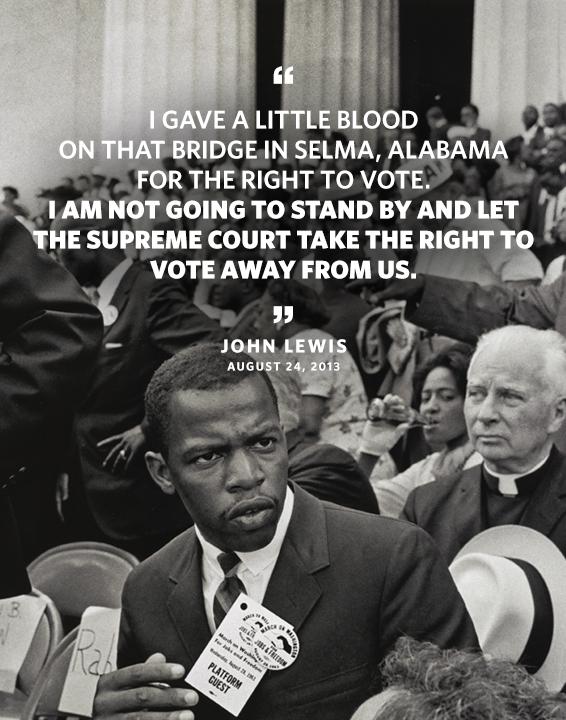Voting Rights in the United States: Voting Rights Act (VRA)
This guide serves as a starting point for legal research regarding voting rights in the United States.
- Introduction
- Voting Rights Act (VRA)
- Reapportionment & Redistricting
- Voter Restrictions
- Staying Current
 Black and white photo of Young Congressman John Lewis, overlaid with quote "I gave a little blood on that bridge in Selma, Alabama for the right to vote, I am not going to stand by and let the supreme court take the right to vote away from us." " width="" height="" />
Black and white photo of Young Congressman John Lewis, overlaid with quote "I gave a little blood on that bridge in Selma, Alabama for the right to vote, I am not going to stand by and let the supreme court take the right to vote away from us." " width="" height="" />
John Lewis Voting Rights Advancement Act
The Voting Rights Advancement Act of 2019 was renamed in honor of late congressman John Lewis. The Act specifically seeks to remedy the wave of voter suppression following Shelby v. Holder by reinstating preclearance requirements and adding other voting protections.
Politico Pro provides the text of the bill, amendments, actions taken on the bill by congress and more.
by Zach Montellaro, writing for Politico, March 29, 2021.
by Ed Kilgore for New York Magazine, April 22, 2021.
published Jan. 28, 2021.
VRA: section by section
via the US Department of Justice, this website lists various cases relating to section 2 of the voting rights act and provides brief summaries.
A brief overview of section 5 and the effect of Shelby County v. Holder on the section from the US Department of Justice.
A Brief History of the Voting Rights Act and its Challengers
The Voting Rights Act of 1965 (VRA) was passed by Congress in reaction to the Civil Rights Movement. Black leaders had been organizing for decades to turn "one man, one vote" into a practical reality for marginalized Americans. Direct action events like the Selma to Montgomery marches in March of 1965 built momentum and pressured elected officials to pass legislation to actualize the voting rights of Black citizens.
The Voting Rights Act notably targeted barriers placed on Black citizens at the state and local level preventing their vote. For examples of common voter suppression tactics both present and historical, view the Voter Restrictions tab of this research guide. The VRA targeted states with a history of suppressing the voting rights of racial minorities, and provided criteria against which to measure whether or not racial minorities were facing such suppression over time in those regions. The VRA was so successful in enfranchising Black Americans because the legislation required those states to receive federal approval before implementing changes to voter requirements (i.e. preclearance). Voter requirements made at the state level without federal approval could not be used to "den[y] the right to vote for failure to comply with such qualification, prerequisite, standard, practice, or procedure."
The VRA has a history of being renewed and extended over time by various administrations while also facing numerous legal challenges in the Supreme Court. The 2013 case Shelby County v. Holder declared Section 4 of the act unconstitutional. Section 4 contained the "coverage formula" focusing on states with a historic tendency to infringe on the voting rights of Black Americans. Invalidating section 4 of the VRA essentially invalidated section 5, which included the language regarding federal pre-approval of voter requirement changes.
from OurDocuments.Gov, a partnership between National Archives and Records Administration, National History Day, and USA Freedom Corps.

 Black and white photo of Young Congressman John Lewis, overlaid with quote "I gave a little blood on that bridge in Selma, Alabama for the right to vote, I am not going to stand by and let the supreme court take the right to vote away from us." " width="" height="" />
Black and white photo of Young Congressman John Lewis, overlaid with quote "I gave a little blood on that bridge in Selma, Alabama for the right to vote, I am not going to stand by and let the supreme court take the right to vote away from us." " width="" height="" />